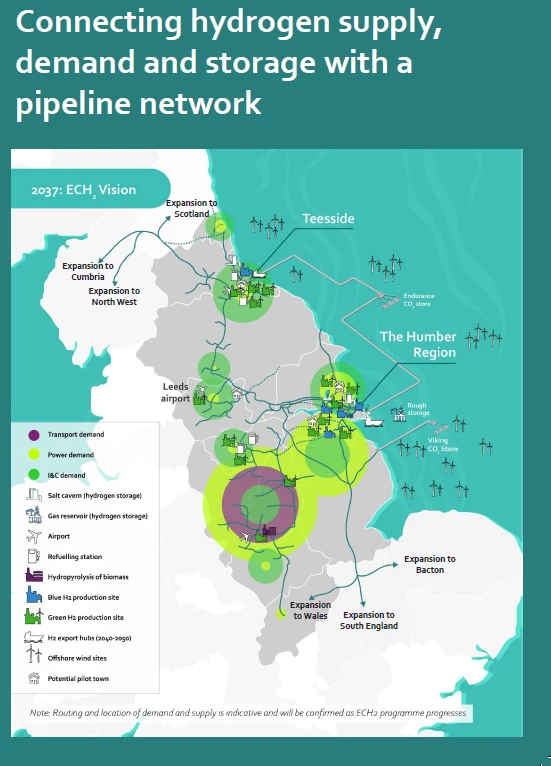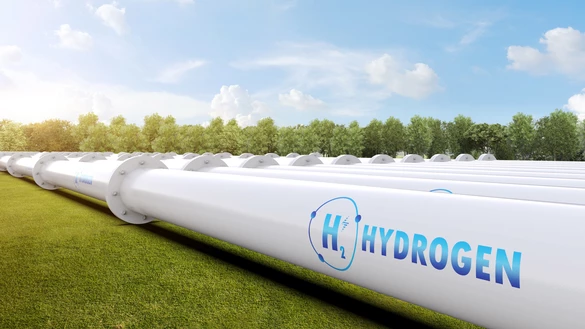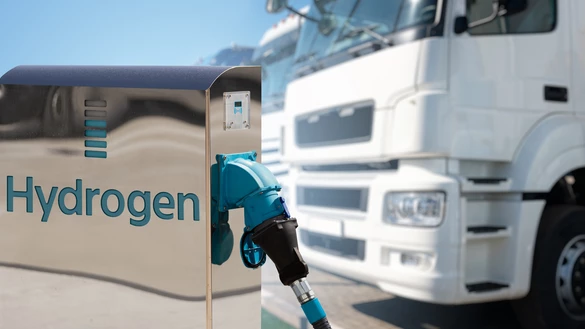- Back
- Balancing
- Capacity
- Charging
- Connections
- Data and operations
- Land and assets
-
Insight and innovation
- Back
- Home
- Insight and innovation
- Transmission innovation
- Summer Outlook
- Winter Outlook
- Gas Ten Year Statement (GTYS)
- Gas Future Operability Planning (GFOP)
- The future of gas-fired generation
- Understanding within-day behaviour
- Identifying future drivers of change
- Changing supply patterns
- Future of gas
- Stakeholder resources

Pioneering Hydrogen Programme to bring low-carbon energy benefits to North East and Midlands
A pioneering hydrogen programme - encapsulating production, storage, transmission and distribution – is set to drive green jobs, skills, and competitive supply chains across the Midlands and North East.
The second phase of the East Coast Hydrogen project (ECH2) will provide the opportunity to connect up to 11GW of hydrogen production by 2030, exceeding the UK Government’s 10GW target within a single region. The hydrogen will replace natural gas - currently essential for industry and power generators – helping to preserve the industrial and commercial value of the Midlands and North East. The detailed Delivery Plan launch takes place in Westminster on Monday 13 November 2023.
East Coast Hydrogen will play a critical role in decarbonising industry and improving energy security by:
- Connecting up to 4 Terawatt hours (TWh) of hydrogen storage by 2030.
- Connecting producers and storage providers to a range of customers, requiring 63 TWh/year of low-carbon hydrogen to decarbonise power generation, aviation, industrial and commercial demand.
- Save up to 12 million tonnes of carbon dioxide per year by 2037 - supporting the UK to meet its 6th carbon reduction targets.
- Switching 44% of reliance on natural gas in the region to low carbon hydrogen.
- Creating world-leading hydrogen hubs in Teesside, the Humber region and the East Midlands, protecting and creating around 360,000 jobs.
The East Coast region hosts concentrated industrial energy demand, significant gas storage and offshore wind power, making it an obvious location to produce low-carbon hydrogen. By providing critical hydrogen pipeline infrastructure, the Programme can enable widespread decarbonisation. Industrial and commercial businesses forecast demand for hydrogen at 156 sites in the regions covered by East Coast Hydrogen, on behalf of 53 large energy consumers.
Projects like East Coast Hydrogen can make real the Government’s national ambitions to deliver 10 GW of low-carbon hydrogen production by 2030 - with at least half of this total coming from green hydrogen produced by renewable sources. The region is home to two of the UK’s largest industrial centres, as well as the UK’s largest inland hydrogen cluster in the East Midlands, and is the location of eight shortlisted government funded hydrogen projects, making up around 30% of successful hydrogen production projects to date.
East Coast Hydrogen is set to become a significant at-scale low-carbon hydrogen centre and will provide resilient and home-grown energy where it is needed most, in particular for energy intensive industries or those generating power across Humber, the East Midlands and Teesside.
Hydrogen is expected to play a major role over the next 20-30 years in reducing the UK’s CO₂ emissions, helping the UK on its journey towards net zero by 2050. East Coast Hydrogen will also support the growth of renewable energy generation, using it to produce and store hydrogen at times when renewable output is high, but demand is low.
This programme is a huge collaborative effort: led by Cadent, Northern Gas Networks and National Gas, the consortium brings in a broad spectrum of members across public and private sectors and responds to the UK Government’s plans for a ‘green revolution’ incorporating hydrogen as a crucial technology to effect significant change.
Sally Brewis, Head of Regional Development at Cadent, said: “We’re ecstatic to be in a position to publicly launch this delivery plan with our partners and consortium members. Our industrial and power generation customers in The Humber, South Yorkshire and the East Midlands are telling us they need hydrogen in huge quantities to decarbonise their operations – often hydrogen is their only viable option. They need a resilient pipeline network that connects them to storage and production sites and our Delivery Plan shows how that will happen. The carbon savings potential is enormous and we’ll help to ensure that our treasured manufacturing industries can stay viable in a Net Zero world, maintaining employment in the regions.”
“It is vital that projects such as this are supported and accelerated, enabling the customers who need hydrogen to make their own investment decisions for the energy transition. Cadent is proud to be a part of driving the future infrastructure that can help enable the achievement of these ambitions”.
Mark Horsley, Chief Executive of NGN said: “Our East Coast Hydrogen delivery plan is absolutely critical to maintaining and building a thriving regional economy, whilst hitting our Net-Zero target. It demonstrates how we can decarbonise industry initially in Teesside, West Yorkshire and the Humber, by bringing hydrogen to the majority of our largest users, many of which are simply unable to function without an alternative to today’s natural gas”
Jon Butterworth, Chief Executive of National Gas, said: “We have a concentration of key assets in the East Coast Hydrogen area and are excited about our role in the vanguard of a Net-Zero future, while still ensuring the continued dependability of natural gas transmission to support Britain through the energy transition. East Coast Hydrogen provides the ideal balance of driving economic growth while still maintaining energy security, securing thousands of jobs and creating thousands of new ones in the process.”
The East Coast Hydrogen programme shares expertise in energy infrastructure development, industrial policy, skills, and innovation to develop the low carbon hydrogen production and storage facilities. Initially, the hydrogen produced is expected to be used for industrial, commercial, and power generation processes, with scope in the future for other applications and usage.
For more information, visit https://www.eastcoasthydrogen.co.uk/
Media enquiries to:
[email protected]/ 07815 465384
[email protected]/ 07966 180881
Notes to Editors:
ECH2 was established by NGN, Cadent and National Gas with the objective of identifying and ultimately delivering the network infrastructure required to support the deployment of low-carbon hydrogen to industrial and power generation customers across the North East, Yorkshire, The Humber and the East Midlands, facilitating their decarbonisation strategies. . A Feasibility Study launched in November 2021 established the case for the Programme and set out the roadmap for completing further investigation and design of the infrastructure required. The Programme will provide a blueprint for deployment of low-carbon hydrogen and provide a starting point for the development of the core network that the UK needs to achieve its decarbonisation goals.
This new Delivery Plan provides an update on the progress made since the Feasibility Study. It provides a detailed overview of the emerging hydrogen economy in the East Coast region, demonstrates the strength of the hydrogen demand, and showcases the production and storage projects will complete the supply chain. The Delivery Plan also provides UK Government and industry visibility of the networks’ pipeline network plans and how they will be phased. This programme supports twenty different UK Government policy commitments on hydrogen and decarbonisation and provides stakeholders with more certainty on the availability of infrastructure to help them progress business decisions.
Cadent
Cadent is the UK’s largest gas distribution network, managing a network of more than 130,000km of pipes which transport natural gas throughout the North West, West Midlands, East Midlands, South Yorkshire, East of England and North London.
Cadent is committed to delivering Net-Zero, which means finding a way to transition all consumers away from the methane in its network today and to clean alternatives like hydrogen. They are delivering this by leading the UK’s work on developing the infrastructure and evidence case necessary to realise this. In the East Coast Hydrogen Programme they are supporting the local hydrogen economy by connecting large scale hydrogen producers with industry, hospitals, airports and power generators in towns and dispersed sites.
Northern Gas Networks
NGN maintain more than 37,000km of gas pipes, covering large cities like Newcastle, Sunderland, Leeds, York, Hull, and Bradford and rural areas such as North Yorkshire and Cumbria.
NGN have led research to assess the suitability of the gas network to transport hydrogen and hosted the first demonstration of 20% hydrogen blending on a public network in Winlaton, near Gateshead. NGN's proposal for Redcar to become the first hydrogen village, with up to 2,000 homes using 100% hydrogen from 2026, is currently being considered by the Government . East Coast Hydrogen presents an opportunity to scale the experience to date into a broader deployment across East Coast region, including homes, commercial and industrial users.
National Gas
National Gas is the backbone of Britain’s energy system today and will play a leading role in the transition to a clean energy future that works for every home and business. Purpose: National Gas through Project Union aims to develop a hydrogen ‘backbone’ by connecting Industrial Clusters and strategic hydrogen production sites, with storage and demand across the UK. Objectives for East Coast Hydrogen include connection of the largest Industrial Clusters in the UK, Humber region and Teesside, to prove the case for hydrogen transportation at scale, whilst connecting these clusters with production, storage and demand points.



